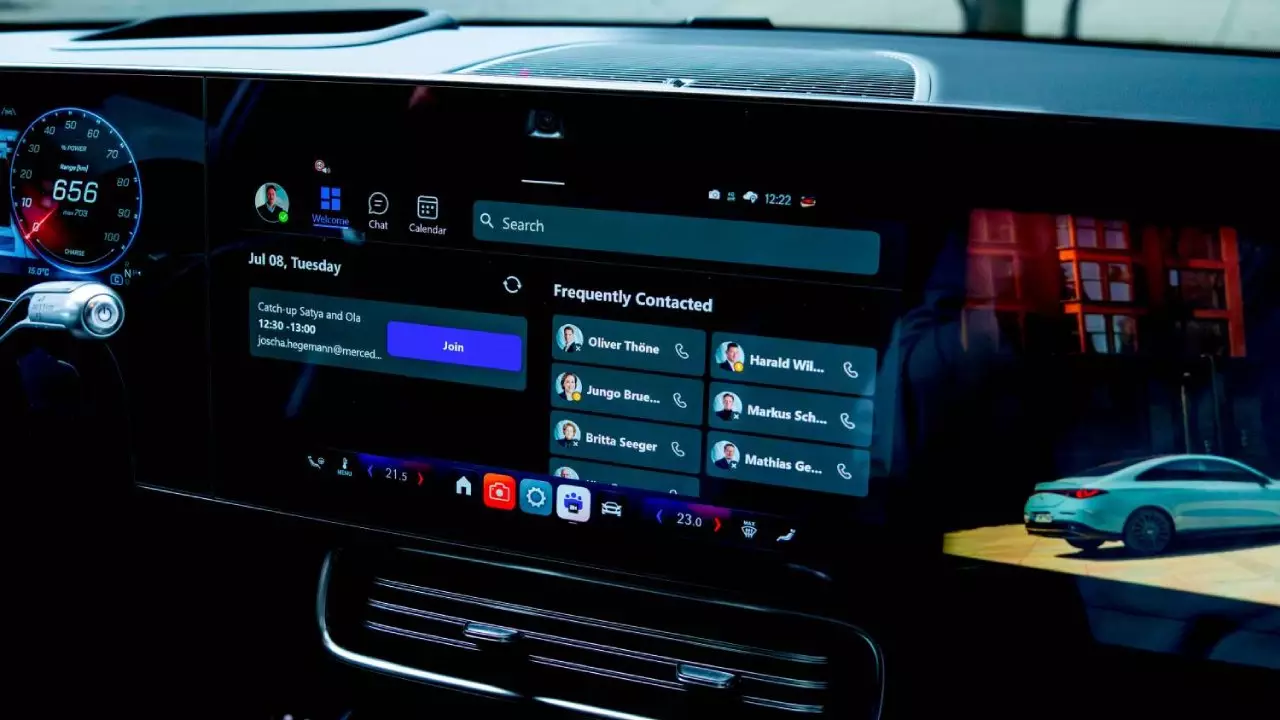In a world where the boundaries between professional and personal life become increasingly blurred, corporate giants like Mercedes-Benz are pioneering features that seem to push this boundary even further. The latest update allowing in-car video streaming to show drivers participating in Teams meetings is a bold step, blending the concept of mobility with productivity. On the surface, this innovation promises unparalleled convenience—allowing executives and professionals to stay connected on the go. However, the underlying implications are fraught with questions about safety, practicality, and the very essence of professionalism.
This new feature, which permits live video footage of the driver to colleagues during a call, feels more like a symbolic gesture than a genuinely useful enhancement. The manufacturer asserts that safety has been prioritized, with the video feed automatically switching off when the vehicle is in motion and limiting visual engagement. Yet, one cannot ignore the inevitable distractions such technology introduces. Even the most cautious driver might find it difficult to completely ignore the allure of a live camera feed, especially if it displays their face, actions, or minor physical behaviors. The risk of inadvertent exposure—be it an unflattering glance at the camera or sharing unintended visuals—raises uncomfortable questions about privacy and professionalism in the digital age.
The Illusion of Safety in a Risky Environment
While Mercedes emphasizes that safety protocols are in place, the reality of using live video while driving remains questionable. The technological safeguards may prevent the driver from actively viewing shared screens or engaging visually with other participants, but the simple fact that the camera is active increases the likelihood of cognitive distraction. Human attention is limited, and the presence of a live video feed—even if only audio—can subtly shift focus away from the road, especially during moments of heavy traffic or complex maneuvers.
Moreover, the idea that this feature is solely for “showcasing commitment” to productivity feels superficial. In practice, it borders on a performative display of work ethic, possibly hinting at corporate pressures that valorize busyness above safety. The temptation to appear constantly connected, constantly working, may inadvertently encourage drivers to compromise safety for the sake of appearances—an especially troubling trend in our always-on digital environment. This innovation, instead of fostering effective remote work, could normalize dangerous multitasking behaviors that threaten both drivers and other road users.
AI Integration: A Double-Edged Sword
Adding Microsoft 365 Copilot’s AI capabilities into the vehicle’s ecosystem sharpens the focus on reliance on intelligent assistance. Drivers will soon be able to summon AI to summarize emails, access client details, and manage daily schedules simply through voice commands. The allure of seamless productivity enhancement in a mobile setting is undeniable. Yet, the flaws of AI technology — especially its reliability and understanding of context — cast a shadow over this convenience.
AI is far from infallible, and its misinterpretations can have dire consequences when used in high-stakes settings like driving. An AI misreading an email or retrieving incorrect client details could lead to miscommunications, mistakes, or even dangerous decisions. Moreover, relying heavily on AI to handle tasks during driving might foster complacency, reducing drivers’ attention to their surroundings and increasing the risk of accidents. Its implementation can be a double-edged sword: a tool for efficiency that, if misused or misunderstood, accelerates potential hazards rather than mitigates them.
The Future of Mobility and Work: A Dangerous Game of Innovation
Ultimately, Mercedes’ push towards integrating advanced communication and AI tools into vehicles is emblematic of a broader shift—transforming automobiles from mere transport to multifunctional workspaces. While such developments seem to promise increased efficiency and connectivity, they also reveal a profound disregard for fundamental safety principles. It’s conceivable that, in the race to be at the forefront of automotive innovation, safety is inadvertently sacrificed on the altar of progress.
This obsession with appearing productive during every possible moment risks normalizing behaviors that jeopardize lives. As technology continues to embed itself into every facet of our mobility, society must critically evaluate whether these advancements enrich our daily lives or simply serve as superficial assertions of dedication and modernity. The challenge lies in balancing innovation with responsibility—something that hasn’t yet been convincingly achieved in Mercedes’ latest offerings. With such powerful tools at their disposal, manufacturers must be more cautious, ensuring that safety and practicality remain at the heart of their vision rather than succumbing to a relentless pursuit of innovation for its own sake.

